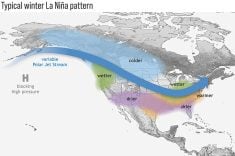LANIGAN, Sask. — A certain brand of mint, according to a famous advertising slogan, was “two, two — two mints in one.”
While there’s no commercial in the works for hybrid brome grass, a similar slogan might be appropriate.
The new forage crop developed by Agriculture Canada can aptly be described as two grasses in one.
It’s a hay grass, providing producers with a good first cut yield like its parent smooth brome.
And it’s a grazing grass, regrowing through the summer and fall like its other parent, meadow brome.
Read Also

Canadian Food Inspection Agency extends chronic wasting disease control program consultation deadline
Date extended for consultation period of changes to CWD program
“You can use it as a dual purpose hay-pasture type of crop,” says Bruce Coulman, head of forage crops research at Agriculture Canada’s Saskatoon centre. “That’s the benefit to the producer.”
He said the feedback so far has been enthusiastic.
“It gives them an option,” he said. “A lot of beef producers like to take a first cut of hay and then graze afterwards.”
The new brome grass, named AC Knowles in honour of Bob Knowles, the Ag Canada scientist who developed it, was on display June 27 at the Western Beef Development Centre’s Termuende research farm near Lanigan, about 120 kilometres east of Saskatoon.
Nearly 300 farmers attended the annual field day to check out the trade show, listen to a few speeches, swap stories with their fellow cattle producers and head out in the buses to tour some of the research projects.
One is comparing plant yield, plant nutrition and animal performance data for the three varieties of brome grass, along with crested wheat grass.
Early trial results
Since the project is in only its second year, it’s too early to report any concrete conclusions. However, Coulman said that earlier small-scale grazing trials at the Swift Current research centre produced promising results.
“That showed it was at least as good, if not better, in terms of animal gain than smooth and meadow,” he said. “So now we want to evaluate it in this setting as well.”
The hybrid’s hay yields are about equal to smooth and greater than meadow, while its pasture yield is better than smooth and comparable to meadow.
With good moisture, the grass can be ready for grazing three weeks after cutting, although on average it would be four to five weeks.
Hybrid brome has lower fibre in the earlier growth stages, then shows equivalence to the other brome grasses during later stages. Crude protein levels are lower at advanced stages.
Meadow and smooth brome won’t normally cross in the field because meadow brome flowers quite a bit earlier than smooth.
Bart Lardner, the beef centre’s co-ordinator of research and technology transfer, said the project has been hurt by dry conditions in the last two years.
Steers have been grazing on the plants for three weeks but will soon be taken off to give the pasture a three-week rest. They will return in late July.
All of the brome grasses are fairly drought tolerant. When meadow brome gets drought stressed, the leaves turn brown, but come back quickly with rain. Smooth brome is deeper rooted and the leaves stay green in dry conditions, as they do with the hybrid.














